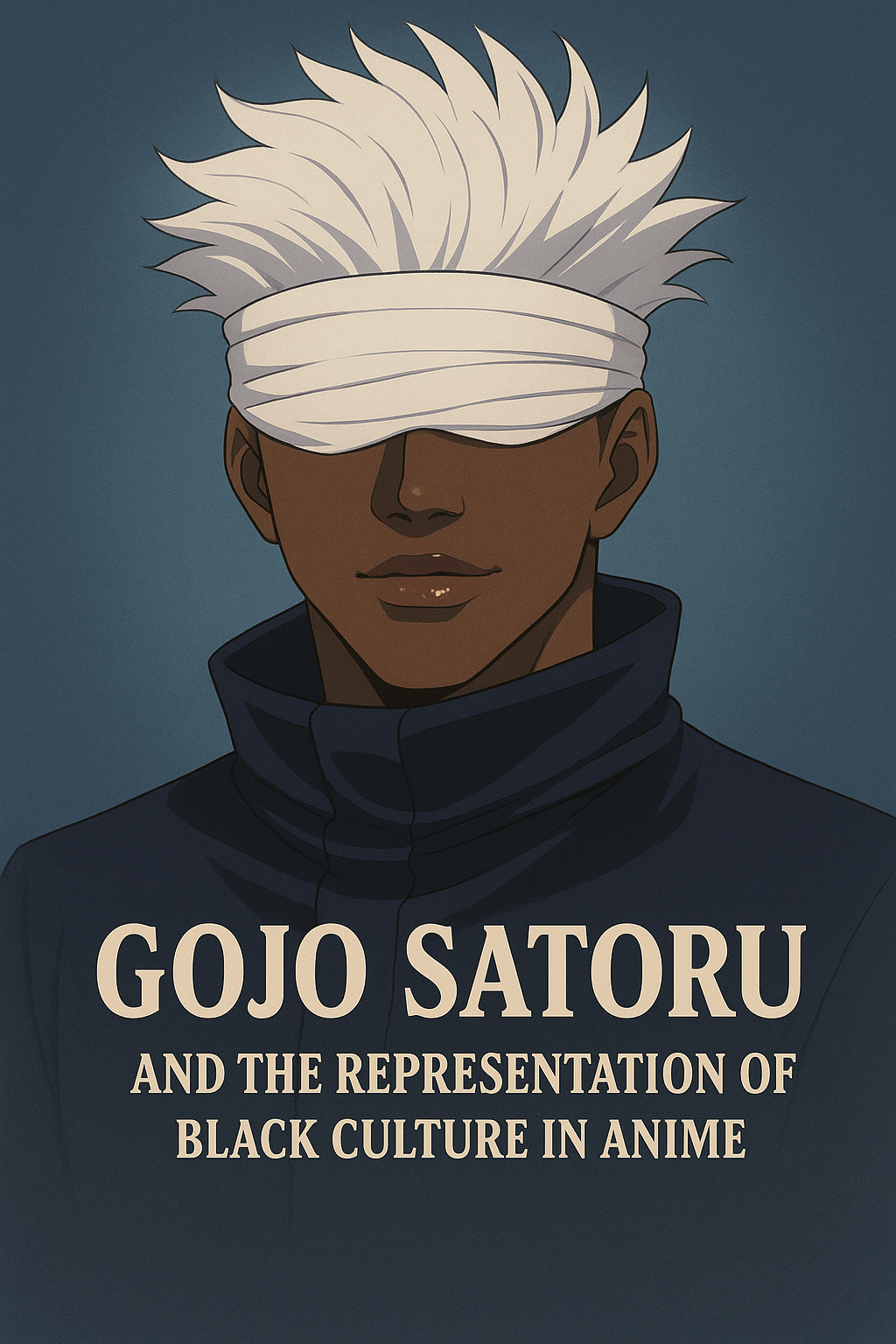Introduction: Gojo, The Rizzler of Jujutsu Kaisen
In the vast cosmos of anime, where flashy hair colors, exaggerated fight scenes, and speeches about friendship dominate the narrative landscape, Jujutsu Kaisen has clawed its way into the pantheon of modern classics. Viewers worldwide have been enthralled by cursed energy battles, traumatized by character deaths, and humbled by the sheer coolness of its sorcerers. Yet, amid this chaos, one man stands taller, shinier, and significantly more “rizzed-up” than all the rest: Gojo Satoru.
Now, Gojo has been labeled many things—“the strongest sorcerer,” “the white-haired menace,” “anime’s finest blindfolded zaddy”—but today, we set aside the mainstream definitions. Instead, we embark on a very serious, incredibly academic, not-at-all-satirical inquiry into Gojo’s true identity as a Black man in anime.
Yes, you heard that correctly. Gojo’s swagger, style, and undeniable aura transcend the ink-and-paper boundaries of manga. He is not just a sorcerer. He is representation. He is glossy lips. He is durag-coded. And he is here to remind us that anime can (and should) reflect the diverse cultural brilliance of the world.
This essay, totally not written on two hours of sleep and a questionable energy drink, will unravel the deep sociocultural threads woven into Gojo’s design. By exploring his glossy lips, durag-coded bandages, and his so-called “fight” with Miguel (spoiler: they were basically sparring homies), we will demonstrate that Gojo Satoru is more than just a fictional character—he is a cultural movement.
Glossy Lips: The Power of Shine
Let’s start with the detail that is simultaneously subtle and impossible to ignore: Gojo’s lips.
MAPPA Studios could have left them dry, cracked, and pale like the majority of anime characters. But no. They chose shine. They chose hydration. They chose lip gloss supremacy.
This single design decision is loaded with meaning. In anime, most characters are cursed with the dreaded “default mouth” treatment: a tiny line or awkward rectangle. Gojo, however, defies this trend. His lips glisten. They reflect light sources that don’t even exist in the scene. They command attention.
And why does this matter? Because glossy lips are deeply tied to Black cultural aesthetics. For decades, clear lip gloss has symbolized confidence, flair, and unapologetic self-expression in the Black community. It’s never just about looks—it’s about radiance, presence, and saying without words: “I am that person.”
When Gojo steps on screen with lips shinier than a fresh coat of Vaseline at a middle school dance, he isn’t just serving aesthetics—he is honoring a cultural tradition. His gloss signals power. His gloss signals individuality. His gloss whispers to the audience: representation matters.
The Durag-Coded Bandages: Blindfold or Fashion Statement?
Anime history is filled with blindfolded characters, but none have rocked the look quite like Gojo. The secret? He’s not just wearing a blindfold. He’s wearing it like a durag.
Think about it: the way he meticulously wraps it around his head, the precise folds, the snug fit, the effortless drape. This is not randomness. This is intentional artistry.
Durags, historically, have been used for protecting and maintaining hairstyles—waves, curls, braids. Over time, they’ve grown into symbols of identity, pride, and cultural heritage within the Black community. They’re more than functional; they’re expressive. They can be silky, velvet, patterned, neon, bedazzled—you name it. A durag is both protection and proclamation.
Gojo’s bandages function the same way. Yes, they suppress his Six Eyes. Yes, they’re technically “battle gear.” But they’re also stylized, fashionable, confident as hell. The bandage-to-durag pipeline cannot be denied.
And this is where the genius lies: Gojo’s choice to rock his blindfold like a durag isn’t just cool—it’s representation disguised as aesthetic. It acknowledges that Black culture has always been ahead in fashion, in expression, in setting global trends. Anime has simply borrowed from this truth, and Gojo embodies it unapologetically.
Gojo vs. Miguel: Homies, Not Enemies
Ah, yes. The infamous Gojo vs. Miguel fight. To the untrained eye, this appears to be a showdown of epic proportions. To those with cultural literacy and common sense, however, it is very clearly a playful scrap between soon-to-be homies.
Let’s break it down.
- Miguel rolls up with the Black Rope, a cursed tool so broken it makes Gojo actually struggle for once.
- Gojo, amused and intrigued, decides to test himself.
- The fight? Competitive, sure. But it radiates sparring energy, not hatred.
Some fans will argue, “But they were enemies! It was serious!” To that, I say respectfully: cap.
This was not some racially charged anime duel. This was Gojo doing what Gojo always does—flirting with danger, flexing his strength, and secretly auditioning Miguel for the homie roster. Their banter, their mutual recognition of power, their post-fight vibes—it screams “playful competition leading to friendship.”
Gojo didn’t obliterate Miguel on sight because he respected him. In anime terms, that’s basically the equivalent of saying: “Bro, you’re invited to the cookout.”
Representation Beyond the Surface
Now, let’s zoom out. What do glossy lips, durag-coded bandages, and sparring homie fights really add up to? Representation.
Anime has long struggled with diversity. Too often, non-Japanese characters are rendered as caricatures, stereotypes, or worse—completely erased. But with Gojo’s subtle cultural coding, we glimpse the possibility of a new era: one where Blackness is not exoticized or sidelined but integrated meaningfully into character design.
Gojo Satoru is not explicitly labeled Black in canon (yet). But through his design choices, his aura, and the cultural cues embedded in his appearance, he represents something powerful: the recognition that anime is not created in a vacuum. It draws from real-world cultures, aesthetics, and communities.
By giving Gojo glossy lips, durag-coded blindfolds, and respectful rivalries, Jujutsu Kaisen challenges the industry to do better. It asks: why not celebrate the full spectrum of human identity in anime? Why not honor the aesthetics and traditions that have shaped global culture? Why not let Gojo shine as the Black king he is coded to be?
Conclusion: Gojo, The Future of Anime Representation
At the end of the day, Gojo Satoru is more than the strongest sorcerer. He is more than the blindfolded Rizzler. He is more than a man with lips shinier than a fresh bottle of Fenty Beauty Gloss Bomb.
He is representation incarnate.
Through his design, Gojo bridges anime and Black cultural aesthetics in a way that feels authentic, celebratory, and deeply impactful. His lips highlight confidence. His bandages salute durag culture. His fight with Miguel reminds us that rivalry doesn’t erase camaraderie.
Anime is evolving, and Gojo Satoru stands at the forefront of that evolution—smiling, lip gloss glistening, durag-coded blindfold secure. He is proof that even the smallest details in character design can carry monumental weight.
So next time you watch Jujutsu Kaisen and see Gojo strut onto the screen, remember: you’re not just witnessing sorcery. You’re witnessing cultural excellence, representation, and the unstoppable power of Black Gojo supremacy.






Leave a Reply